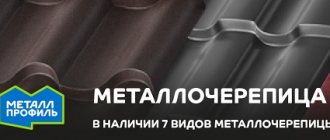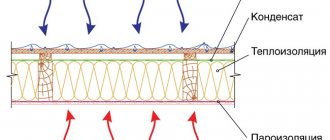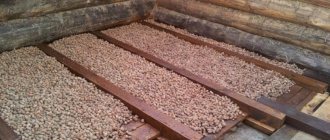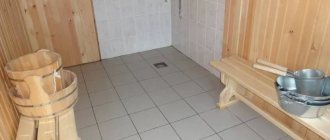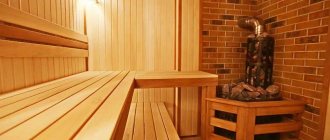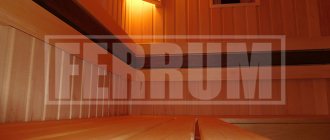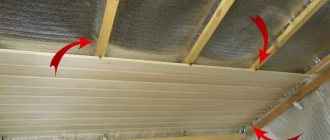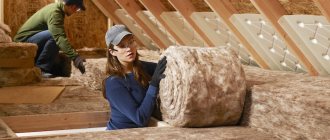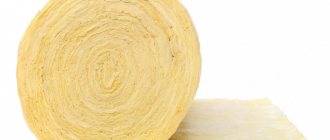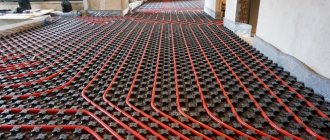Sauna vapor barrier diagram
Good afternoon, blog readers and all those who like to take a steam bath!
Today I propose to talk about the service of the latest modern technologies to improve your mood from visiting the steam room. Let's get straight to the point...
Foil vapor barrier for a bathhouse has a lot of useful unique qualities. In particular, this is the ability to create a “thermos effect”, which allows you to warm up the room faster while saving on fuel.
Agree that everyone prefers an individual thermal regime in their steam room - some are constantly drawn to “sprinkle” water on the stones, while others prefer a more moderate atmosphere. To ensure the comfort of all visitors, the choice of optimal vapor barrier is required.
Expanded polystyrene
Whatever you call polystyrene foam, even polystyrene foam, it will not cease to be polystyrene foam. If there is truly folk material that is used everywhere, then this is it.
- easy;
- cheap;
- simple installation;
- perfect heat retention.
How can you resist and not buy into these advantages? Meanwhile, if you are thinking about choosing a material for insulating the ceiling in a bathhouse and choose polystyrene foam, be prepared to face a number of very serious disadvantages:
- at temperatures above 60 degrees, the material deteriorates with the release of substances hazardous to health
- flammable;
- depressingly low vapor permeability;
- not friendly with aggressive substances.
One conclusion can be drawn from all this - it is not recommended
. Unless, of course, one day you want to lose your outlet due to a fire. Or any other accident.
As a compromise for insulating the ceiling in a bathhouse, we can only recommend the so-called extruded polystyrene foam, which, compared to other types of foam, is quite fireproof and can withstand temperatures up to 120 degrees without any signs of deformation. However, it also costs more - from 5.5 thousand rubles per cubic meter
Methods for laying lining
Before choosing a method for laying lining, the first thing repair professionals advise to start with is to assess the humidity in the room. If finishing is needed in a steam room, then you should focus on horizontal placement of the slats. Vertical installation is suitable for a dressing room or sauna. This is due to the fact that the “vertical” method has a number of disadvantages:
- There will not be sufficient air circulation between the foil and the lining; this will lead to the formation of condensation and the development of mold on the inner surface of the trim and the sheathing beams.
- The finishing below will begin to deteriorate from moisture faster than the upper elements. With a horizontal mounting method, it will be enough to replace the lower strips. If you decide to attach the trim vertically, in the future you will have to trim each plank from below to replace the damaged area.
- When gaps form between adjacent elements, moisture will get inside and not flow down, as happens when installed horizontally.
The vertical method of attaching planks takes less time, so it is more often used by hired craftsmen. Also, the vertical placement of the lining does not make the room visually lower. Most often, to combine practicality and convenience, two installation methods are used simultaneously. In this case, the lower section of the walls is trimmed with horizontal planks so that, if necessary, they can be easily replaced. And the upper half of the wall is sheathed with vertically arranged boards.
The main requirements for materials and raw materials: insulation for a bathhouse on the ceiling, which is better and more reliable
When the entire structure has already been built, and all systems have been well thought out, it is worthwhile to take up insulation, especially if you plan to use the bathhouse throughout the year, regardless of the season. Moreover, in the sultry summer and cold winter, this will be equally useful and simple if all the calculations for insulation are correctly made, especially the ceiling, from where the lion's share of the heat from inside the room can be ventilated. To begin with, before you figure out how you can insulate the ceiling in a bathhouse, you need to understand that this material must meet special requirements, otherwise it’s simply not worth taking it, it will be wasted funds, and now is not the time to risk your own money.
Important
It is worth understanding that, first and foremost, the insulation in a bathhouse on the ceiling, the builders forum is replete with similar statements from real professionals, must be moisture resistant, since all the hot steam first rises. Moreover, you should not hope that vulnerable material that absorbs water can be reliably hidden under a vapor barrier. It will, of course, help a little, but such an insulator can still become unusable and completely lose its properties in just a couple of years, due to the regular appearance of condensation, which is inevitable with temperature changes.
- Also, the insulation for a bathhouse on the ceiling must be completely harmless and not dangerous to human health and life. That is, it should not release toxins, aldehydes, or other dangerous substances, even under the influence of high temperatures that will regularly occur in the bathhouse.
- Fire safety is another important factor that insulation for the ceiling in a bathhouse must have, and which one is better under this criterion, they will help you figure it out, for example, in a store.
- We should not forget about sudden changes in temperature, which the thermal insulation indoors must withstand without much reaction, and over a long period of several years.
- Biological and chemical inertness, as well as resistance to the development of various microorganisms, fungi and other “living creatures” of the material for bath insulation is also extremely important.
Among other things, I would like to definitely note that the heat-insulating layer must be sufficiently tight and elastic, but such that, for example, it itself will not sag over time. Therefore, in order not to be too tormented by the question of which insulation to choose for the ceiling of a bathhouse, it is worth purchasing one that is relatively inexpensive, but in terms of performance and properties is at its best. Moreover, it is worth understanding that this can be done using natural materials, or you can choose synthetic ones, which also “work” quite well.
Selection of foil material
Rolled heat insulator
Thermal insulation with foil for a bath differs in technical characteristics and properties. The choice of insulation is influenced by the structural features of the room, fire safety requirements, and the complexity of installation. Mineral wool is recommended for stone and concrete buildings. This is a reliable material of considerable thickness that will provide an appropriate level of insulation.
A building made of timber or logs does not require much effort to maintain temperature. Wood itself is a good heat insulator. In this case, penofol or kraft foil is sufficient. A review of popular options will help you decide which material is best to use.
Rolled heat insulator
Insulation in the form of a rolled sheet can be from 20 to 150 m long. The thickness of the material ranges from 2 to 40 mm. The basis is foamed polyethylene or propylene. Thanks to the thin coating of aluminum, the material reflects thermal radiation. Penofol is popular in the domestic market. The material is produced with one-sided or double-sided foil coating with a self-adhesive base.
Rolled foil without a base is laid on the surface of the walls after the insulation. Strips 1-1.5 m wide are mounted overlapping. The resulting surface is highly resistant to temperature (up to 650°C), moisture and steam.
Basalt wool with foil layer
Basalt wool with foil
Mineral or basalt wool is a universal fiber insulation. It is resistant to fire and moisture, provides excellent thermal insulation of the room. Foiling the outer layer reduces heat loss and creates a vapor barrier. Among the assortment of leading manufacturers Izover, Parok and Rockwool, you can select special materials with foil for insulating a bath.
- For anti-condensation insulation, ROCKWOOL ALU is recommended. The material is supplied in mats. Its fibers are located perpendicular to the surface. During operation, the strength and elasticity of wool is not lost. The Sauna Butts series is designed for insulation of saunas and baths. Mineral wool slabs with a thickness of 50 and 100 mm serve as heat and vapor insulation. The material is intended for indoor installation.
- Izover Sauna roll insulation is quickly installed on walls and floors and provides reliable insulation. It is safe for health and does not produce harmful emissions when heated or wet. The material allows you to save on the installation of membranes and films.
- The popular insulation of the Paroc brand is offered in the form of lamella and stitched mats. They are easy to use and can be quickly mounted on an insulated surface. The aluminum layer is reflective. Basalt wool does not change its thickness during operation.
Kraft foil
The use of insulation with a layer of aluminum allows for maximum preservation of infrared radiation inside the steam room. The multilayer construction consists of kraft paper and foil, in some cases polyethylene is added to reinforce the material. Common types:
- foilsolone or foil glassine - an elastic material based on cardboard with a corrugated aluminum coating;
- foil-fabric - fiberglass insulation, backed with foil, reflects up to 97% of radiation, withstands temperatures of about 200°C;
- isolar – bath foil 50 and 100 microns thick with the addition of polyethylene film, resistant to fire and temperatures up to 300°C.
Among the types of insulation, it is worth noting a new product - PIR slabs from TechnoNIKOL with a foil lining. The line of bath insulation products creates a reliable barrier between the cold from the street and the hot, humid air of the steam room. The plates are lightweight, low water absorption, and resistant to deformation
Suitable wood species
Wood for lining should not contain a lot of resinous substances.
When choosing the type of wood for lining a bathhouse with lining, take into account the purpose of the room. Coniferous boards are not recommended for cladding a steam room. Due to the high temperature, they release resin, which causes burns upon tactile contact, and aromatic components, which in high concentrations provoke an allergic reaction. Steam room decoration uses hardwood:
- Linden - the low heat capacity of lumber, the pleasant aroma and golden hue of the boards ensured the popularity of lining when finishing saunas. The wood is durable, easy to process, and lasts a long time in extreme conditions.
- Alder - the lamellas have a reddish tint, and when heated, they release healing tannins. The wood dries quickly and is resistant to moisture. It has a soft structure with a small number of knots. One of the advantages is the affordable cost.
- Aspen is a light-colored species that does not deform from moisture or temperature fluctuations. The lining heats up slightly and is safe for use in a steam room.
After cladding, the wood is coated with moisture-repellent compounds.
For other rooms, lining the inside of the bathhouse with clapboard can be done with any type of wood:
- Larch is the wood that is most resistant to moisture, has a solid structure and a beautiful pattern. Due to its strength it is difficult to process.
- Pine – has a pleasant aroma and is not subject to rotting. The material is strong and durable, suitable for cladding dressing rooms and rest rooms.
- Spruce board is distinguished by a small number of knots and resin, the light shade does not darken over time. Advantage – low cost.
- Cedar is an expensive reddish-brown material that emits a pleasant aroma with medicinal properties. Wood is not afraid of moisture and has high thermal insulation characteristics.
When choosing a lining, its grade is taken into account. For a steam room, class A or extra material is required. Such lamellas have a smooth surface without knots and defects, which during operation become a source of cracks and deformation. In other premises, the use of class B products with minor defects on the surface is allowed.
Characteristics and properties of foil
One of the most important characteristics of aluminum foil is its reflective ability - up to 97% of infrared rays. Continuous covering of the steam room with this material contributes to maximum heat retention, because IR rays are not absorbed by the walls, but are reflected back into the room. And even if the surface of the foil fades over time, this will have virtually no effect on the reflective properties.
Foil on the bathhouse ceiling - photo
In addition, it can withstand temperatures up to 300 °C and higher, depending on the brand, has a low specific gravity and does not emit compounds harmful to the body.
Bath foil
This material also has other important properties:
Almost all the heat remains in the steam room, and the walls and the insulating layer under the foil are reliably protected from condensation. For greater efficiency, not only the walls, but also the ceiling are sheathed with foil, because steam and hot air first rise upward. Attaching it is not difficult, the main thing is to avoid its deformation during operation and not leave gaps between the panels.
Foil is produced in rolls and sheets, the thickness is from 0.007 to 0.2 mm, the width of the tape is from 1 to 150 cm. Depending on the manufacturing method, it can be annealed (soft) and unannealed (hard), and this is indicated by the marking - the letters "M" and "T" respectively. Both types are suitable for thermal insulation of rooms. It is recommended to sheathe the steam room with foil from 30 to 300 microns thick.
Photos of the appearance of rolls of reflective insulation Megaspan FB for baths and saunas
Areas of use
The installation of reflective heat-insulating material, insulation of enclosing structures, ceilings of a bathhouse - all this can be done directly on a log or beam with a foil surface facing the inside of the room. In this case, the joints of the heat-insulating layer are carefully glued using aluminum tape.
An air gap is required, and the thickness between the interior decoration of the steam room and the reflective thermal insulation should be 10-15 mm. To ensure condensate drainage at the junction of the wall and the floor surface, it is necessary to perform a small release of the canvas.
Requirements for insulating material for a bath
The operating conditions of the bathhouse differ from other premises. High temperatures and humidity require a special approach to the selection of building materials. This applies no less to thermal insulation.
Since bath procedures are used for healing, the evaporation of harmful substances should be excluded. In different rooms of the bathhouse, the requirements for insulation differ. The most extreme conditions are created in the steam room, where the temperature can reach 160 °C.
If insulation is done from the inside, different materials may be used in different rooms. When insulating the ceiling from above (from the attic side), it is wiser to use one insulation material. The material must have the following properties:
- low thermal conductivity;
- moisture resistance;
- resistance to high temperatures;
- no harmful fumes when heated;
- resistance to rotting and fungal growth;
- durability.
The safety of the material must be confirmed by a sanitary and hygienic certificate.
Correct installation
Thick foil insulates the walls of the room from the increased influence of moisture and high temperatures.
For work you will need:
- foil insulation;
- stapler;
- hammer, nails with wide heads;
- metal adhesive tape.
The main mistake in attaching the material is the incorrect location of the reflection layer. The shiny surface of the sheet is directed into the building, with the paper facing the wall. The joints are never overlapped; they are glued together with aluminum tape. The canvases are fixed using a construction stapler.
To fix the insulator, which has an adhesive base, additionally glue it pointwise with rubber glue. After laying and gluing the sheets, the coating is fixed with wooden lathing.
Insulating the ceiling in a bathhouse: how?
| Mineral wool (basalt wool) | A product of processing natural stone, it does not burn, does not melt, but crumbles into dust. |
| Ecowool | Non-flammable cellulose, environmentally friendly, with low thermal conductivity, relatively cheap. |
| Foil | This is not insulation, but a reflector of infrared radiation, made of aluminum, and often industrially combined with insulation materials. |
| Expanded clay | A product of firing clay, light and cheap, but it is worth checking the background radiation. It exhibits thermal insulation properties in a layer of 20-30 cm. |
| Expanded vermiculite | Withstands up to 1300 degrees! And thermal conductivity is better than foam. Does not cake during use. A 10 cm layer reduces heat loss by 92% |
| Clay + straw | A popular method of insulation, very cheap, but requiring increased strength of the foundation and walls. |
| Sawdust + dry cement + slaked lime + clay | Cement and slaked lime make sawdust less flammable and repel rodents; clay or sand is added to make it heavier. |
About insulation with clay, sawdust and other folk remedies, see more details here.
Insulating a bathhouse with aluminum foil is a simple and inexpensive lining
How to use foil in a bath
When choosing a suitable method of thermal insulation, the materials of the bathhouse are of paramount importance. Insulated buildings made of logs, the walls of which have been caulked, do not need a foil layer. Large wooden baths with insufficient heating are protected with thin foil. To speed up the heating of the steam room, the surface behind the stove is also covered with foil.
For aerated concrete baths, any foil is suitable - standard or laminated (consists of an aluminum layer and paper). Insulation of brick baths and frame buildings is also a mandatory step. For cladding, foil materials with the addition of cotton wool or polystyrene are used. When covering the ceiling, foil is selected based on the size of the ceilings and the presence of thermal insulation in the attic.
The procedure for operating the steam room also plays a role. If you regularly use the bathhouse, there is no need to use foil for insulation (if you only go into the steam room for a short time). If bath procedures take 1-2 hours or more, the use of foil is 100% justified.
Foil thermal insulation solves two problems at once: it saves fuel and retains accumulated heat for a long time.
Standard cladding
All surfaces are suitable for protective wall cladding. The work is carried out in the following sequence:
If the entire steam room is covered with foil, then first of all the material is fixed to the ceiling. 10-centimeter overhangs are left along the edges. In the process of covering the walls, the foil is applied overlapping to avoid the formation of gaps.
Sheathing over insulation layer
Before fixing the foil, slats 2*4 centimeters thick are laid on the walls in steps of half a meter. The arrangement of the slats can be vertical or horizontal. When carrying out work, the procedure is as follows:
There is no need to cover the corner adjacent to the stove with foil. The exception is cases of wall cladding with decorative materials. Under such circumstances, the thermal insulation must be cut along the masonry area and reinforced with strips.
https://youtube.com/watch?v=Dg14p8ePMhU
Forewarned is forearmed
When doing insulation with your own hands, you can make a number of mistakes. What you should pay attention to when insulating a bathhouse with isolon:
- Isolon foiled on both sides is used to insulate the steam room. The material will not only reflect heat inward, but also cold outward.
- The joints and places where the isolon is attached must be sealed with tape. Otherwise, moisture will get under the material and the metal fasteners will become corroded.
- The joints between the ceiling insulation and on the walls are also taped.
- The insulation is applied 5 cm away from the floor, so that moisture from below will not get under the material.
- For a small bathhouse in a country house, insulation with a thickness of 50 mm is suitable, for a constantly used steam room - 100 mm.
- Wooden walls must be coated with antiseptic compounds before insulation; they also come with slats for lathing for finishing.
- You should not leave the isolon open for a long time; it can be easily damaged by any hard, heavy object.
- You should not finish a bathhouse made of wood with natural moisture until it shrinks completely, as the isolon may warp.
It is better to attach a natural, breathable finish on top of the isolon, for example, linden lining.
It is better to carry out work in the warm season, since the tape will not stick well at subzero temperatures.
By following all the rules, you can perform high-quality insulation of your bathhouse with isolon. The correct installation will determine when you will have to carry out repair work, which is not cheap. Save your money and personal time, and let the steam in your sauna be light and warm!
Brief overview of types and brands of foil insulation
Aluminum foil is an excellent sealant and reflector. These qualities contribute to both rapid heating of the walls and air in the room and long-term maintenance of high temperatures. Thin film with a mirror surface is not the only option; the industry produces many types of thermal insulation based on it.
Varieties of materials for arranging baths and saunas
Folgoizolon. It is a foil insulation made of foamed polyethylene or polypropylene with a thermal conductivity of 0.031 W/mK. The second of them is PPE with a density of 33 kg per cubic meter. m, has a thickness from 1.2 to 50 mm. The first, denoted by the abbreviation NPE, is a low-density material - up to 31.7 kg per 1 cubic meter. m. Its maximum thickness is 15.5 mm. The shape is rectangular, square sheets or rolls, covered with foil on one or both sides.
Foil with mineral wool as a base. It is a heat-resistant foil insulation for a bath with high thermal insulation ability. On sale there are rolls and rigid slabs 5-10 cm thick with a thermal insulation layer of 8 to 10 mm. The main term can hide both basalt wool, obtained from the melt of volcanic rocks, and glass wool, made from glass and quartz sand.
Kraft foil. High-strength paper-based foil for baths. This category also includes three-layer material containing cellulose, a thin layer of polyethylene and an aluminum coating. Foil on kraft paper or fabric is the best option for a bathhouse. Operates in a temperature range from 50 to 100 degrees C. If installed correctly, it reflects up to 95% of heat. Sold in the form of sheets 0.03-1 mm thick or rolls 1 m wide and 30 m long.
What is "Penofol" and its types
Under the Penofol trademark, a thin material with a dense structure and high thermal insulation properties is produced. To achieve a good effect, a thickness of no more than 10 mm is sufficient. "Penofol", in addition to its main function, acts as a sound insulator, and also does not allow moisture to pass through from the outside, is hypoallergenic and resistant to mechanical stress. The material is produced in rolls, which is very convenient for transportation.
The following brands of these products are sold:
-A - there is a layer of foil on one side, it has a wide range of operating temperatures - from -40 to +150 degrees;
-B - double-sided foil coating, operating temperature range -40 - +300 degrees;
-C - one side is equipped with a self-adhesive layer, the other is simply foil. Operating temperature in the range -40 +80 degrees. A standard roll is 50 m long and 1 m wide.
Stitched and unstitched “Izolon”
Izolon is produced at the Izhevsk Plastics Plant; the material with foil is often used as insulation for bathhouses in locker rooms. Depending on the technology used, a distinction is made between “cross-linked” and “non-cross-linked” materials. The second type of product is foamed polyethylene with an unbound molecular structure, and in the first it is modified, which improves its characteristics.
The insulation is covered with foil on one or both sides. It is designed for operation in the range from 60 to 105 degrees. It is supplied to retail outlets in rolls, mats and tapes. For ease of installation, look for self-adhesive foil insulation. The sticky layer is protected with special paper or film.
"Isover" from
This roll material with a fiberglass base is produced by the famous French company. Foil isover reflects heat well, as it is covered on one side with foil reinforced with fiberglass.
Durable mineral fibers have a unique structure. They contain thermal additives that allow them to withstand temperatures up to 400 degrees.
The quality meets international and European standards. There is only one drawback - possible separation of fiberglass particles, so installation must be carried out using protective equipment.
Insulation for frame buildings URSA
URSA foil insulation is produced by a Spanish company. Its basis is glass charge or staple fiberglass. The production technology also requires the use of dolomite, sand, soda, and other minerals in the manufacturing process. The result is thin fibers glued together with a special composition. Thermal insulation in the form of slabs or in rolls is dense and flexible, fits well on the surface.
For frame saunas and baths, the most suitable material is URSA M-11 foil with good heat-reflecting and vapor barrier properties.
